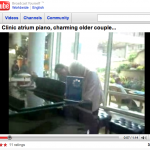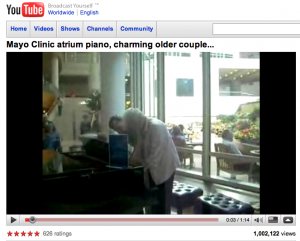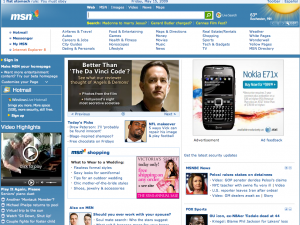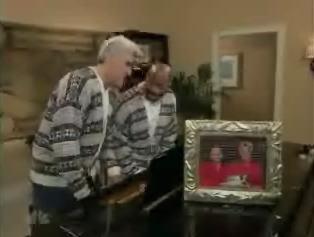This is not a post about “How I created a viral video and you can, too.” It’s simply a story that I think you will find interesting, and from which you can learn. Your mileage will vary, but there are some worthwhile lessons for anyone interested in using social media from a business perspective.
At Mayo Clinic, we have been actively exploring and adoption social media tools. We did our first podcasts in September 2005. We set up a Facebook fan page in November 2007 and our Twitter account in April 2008. We’ve been actively uploading to our YouTube channel for a bit over a year, and have developed several blogs over the last 18 months or so.
We took a major step in January by establishing Sharing Mayo Clinic, our culture blog. This gave us a place to publish feature stories that don’t fit in our news blog or podcast blog.
With that as background, here’s our first viral video story:
On April 7, 2009 I got an email (a few of them actually) alerting me to a charming video featuring Marlow and Frances Cowan, an elderly couple from Ankeny, Iowa. The Cowans had been recorded doing a piano routine in the atrium of our Gonda building in Rochester. I thought it was fantastic, so I decided to embed it in Sharing Mayo Clinic. As of that time, the video had been seen 1,005 times since being uploaded in September 2008. By the next day, it was up to 3,805 views (click to enlarge)…

…and a week later it was at 26,973.
Meanwhile, on Twitter I noticed someone tweeting about her friend whose video of an older couple was getting lots of views on YouTube. A few tweets later she had introduced me to Jodi Hume and her mother, Sharon Turner. I got to have a delightful conversation on the phone with them, and that led to Jodi writing this post for Sharing Mayo Clinic (with Sharon’s permission), including a video of them describing what had happened on the day they shot the video.
The following week, we held our first Tweetcamp, a training session for Mayo Clinic staff to help them gain familiarity with Twitter so they could think of ways to use it in the health care environment. Tweetcamp was open to people outside Mayo Clinic as well, via conference call (and Twitter), to help Mayo staff see Twitter’s broad reach. I used my interaction with Jodi as a Twitter case study, and in so doing tweeted the link to our Sharing Mayo Clinic blog post to the Tweetcamp participants, which led to some re-tweets.
Doing Tweetcamp led to Mayo Clinic (and me) being included in this Good Morning America story about Twitter in health care. The Cowan video wasn’t shown, but Mayo being featured did lead to some additional traffic and followers for our Twitter account and Sharing Mayo Clinic blog.
On April 26, the Minneapolis Star Tribune ran a story about our Mayo Clinic social media programs, which included this paragraph:
Recently, Aase found a six-month-old YouTube video of an exuberant white-haired couple playing the piano in the clinic atrium, to the surprise and pleasure of onlookers. He posted it on Sharing Mayo Clinic. In two weeks, the number of views soared from 1,000 to over 68,000.
Because the article wasn’t published online until April 29, and even then didn’t include a direct link to the video on YouTube or or Sharing Mayo Clinic post, the traffic continued to build gradually, reaching 187,000 views by Sunday, May 3. That was the day the video was featured on Fark.com and Random Lunatic News (something to which we all aspire, I know), which made viewership really start to take off. Here are the running totals of cumulative views:
- May 4 – 228,055
- May 5 – 292,776
- May 6 – 350,777
- May 7 – 403,000
- May 10 – 555,675
Later that week we pitched the story to the Des Moines Register, the metropolitan paper nearest the Cowans’ home town. Columnist Marc Hansen did a tremendous profile, which was published May 10.
For the next few days, the views continued to swell.
- May 11 – 608,141
- May 12 – 692,713
- May 13 – 776, 352
- May 14 – 866,644
The video broke the 1 million mark on YouTube on May 15:

…which also was the day a “pirated” version was featured on the front page of MSN.com, getting another 130,000 views or so (click to enlarge):

Whereas the video had been seen 1,000 times in the six months before April 7, now it was being viewed 5,000 times an hour. And the more people who saw it, the more it was tweeted, posted to Facebook profiles and emailed.
That traffic continued for a couple of weeks. My travels led me to Ankeny, Iowa, where I was able to interview the Cowans myself and post it to Sharing Mayo Clinic. They accepted an opportunity to travel to New York City to be featured on Good Morning America May 27, which means they were seen live by more than 3 million people. Here is the GMA segment.
And finally, we were bemused to find out that Jay Leno had shown a portion of the YouTube clip in his Thursday night monologue, complete with a knock-off video of his own. Screen shots below:
As of this writing (May 31, 2009), the total views on YouTube for this video are up to 2,643,344. You can see the latest total and view the video for yourself here.
10 Lessons/Observations:
Scott Meis has done some good analysis of this video, and I recommend you get his take on this, too. But here are some things I see as major lessons:
- There’s no substitute for a great video. We have several other good videos that have gotten nice traffic, but none of them have remotely approached the views garnered by the Cowan video. We’re really glad Jodi and her mom captured this moment.
- Having an established social media presence can help launch a great video to prominence. At the time we embedded the Cowan video on Sharing Mayo Clinic, we had more than 6,000 Facebook fans and 3,000 Twitter followers. I had more than 2,000 followers on my individual Twitter account. This provided a strong base from which to start spreading the word. And having a blog where the content was appropriate to embed was essential.
- “Sharing” Tools Encourage Sharing. Posts on our Sharing Mayo Clinic blog typically include a social bookmarking toolbar. This makes it much easier for people who have accounts on Facebook, Digg, StumbleUpon or other sites to share interesting posts with friends. They work.
- Listening in Twitter Opens Opportunities. Meeting Jodi via Twitter led me to her mom’s touching story, which Jodi posted on the blog. That story has been viewed more than 77,000 times.
- Social Media can lead to mainstream media coverage, but mainstream media stories without links have small effects on Web traffic. A print story without a Web version will likely have a minor effect on traffic, as we saw with the Star Tribune and its 3-day delay in moving the story to the Web. Likewise, a TV story without an online version, even a national network feature like Good Morning America, doesn’t necessarily translate to a huge spike in page views. People who see it have to search for the video. That’s work, which introduces friction into the viral phenomenon, making it more complicated to pass it along.
- Mainstream media stories with links can have a strong impact. See for example the story in the online Des Moines Register. When all you have to do is forward a link, ideas can spread rapidly. This is what Seth Godin calls the “smoothness” factor in an ideavirus.
- Twitter is among the smoothest mechanisms for spreading an ideavirus. A re-tweet (particularly in Tweetdeck or Twhirl) is virtually effortless. So if you like something, passing it along to all of your Twitter followers is easy. Easy sharing of a “catchy” idea leads to rapid growth.
- Sites like Fark.com build viral video traffic faster than mainstream sites. On social sites, everything is optimized for smooth sharing. So after this video was on Fark.com, it’s views doubled within three days. Many mainstream sites don’t even include external links, in hopes of keeping visitors from leaving. But still…
- A mainstream media story can be a worthwhile end in itself. Just over two million people had seen the Cowans through YouTube as of May 27. More than three million people saw them on Good Morning America that day alone. Even though the YouTube views have “only” increased by about 600,000 since then, being on the program reached many viewers who would never have seen it online.
- The “virus” sticks with the site where the video was first embedded until it gets significant mainstream media. Because Sharing Mayo Clinic was the first site embedding the Cowan video, and because that post was Tweeted and posted to Facebook profiles, a majority of the first million views came through that post. Viewers passed along the post carrying the video, not just the YouTube link, because that was easier. Once the Cowans got on Good Morning America, however, many people looking for the video either went straight to YouTube or chose the YouTube from the Google results.
This was my first experience with a viral video. I learned a lot. I hope my observations (and Scott’s) are helpful to you.


Very good work Lee.
Let’s hope this and more examples to come, can show companies, organizations and communications professionals around the world how to take risks and engage online with their publics.
The most important thing, i think, is that this is a very beautifull story that diserves to be told and which people can relate to.
Congrats Lee and Mayo for this. Keep’em coming.
Fantastic insight and a slew of great points, thanks for sharing Lee. Thanks for breaking it all down for us. I had no idea about the Leno plug, that’s crazy. All around, a great case study.
Lee, I love your point about “no substitute for great video.” My question… did you know right away you had a golden nugget? Do you have any insight on how to spot these great video opporunities?
Lee, this is an amazing story. From a little video with a few hits to a parody on Jay Leno? You can’t make up this stuff! : D Just shows how putting your foot into social media can pay great dividends when you lease expect it! “Viral” may mean bad things in medicine, but man, on the internet it’s fantastic!